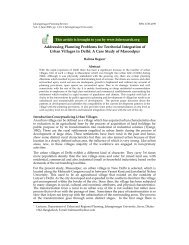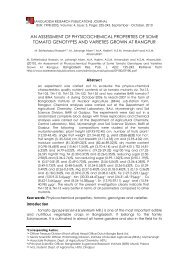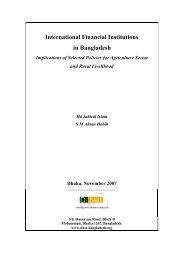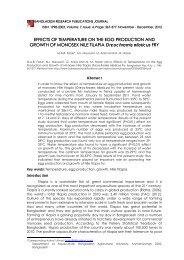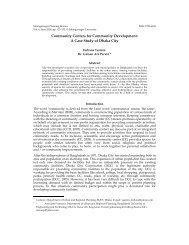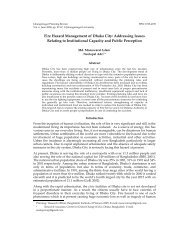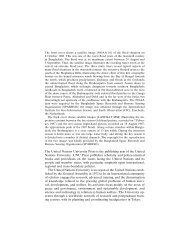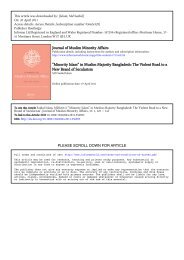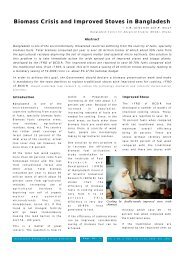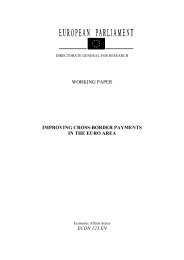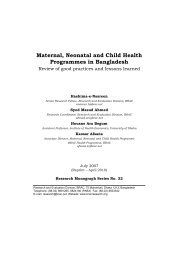Effects of Working Capital Management and Liquidity - Bangladesh ...
Effects of Working Capital Management and Liquidity - Bangladesh ...
Effects of Working Capital Management and Liquidity - Bangladesh ...
You also want an ePaper? Increase the reach of your titles
YUMPU automatically turns print PDFs into web optimized ePapers that Google loves.
Quayyum: <strong>Effects</strong> <strong>of</strong> <strong>Working</strong> <strong>Capital</strong> <strong>Management</strong> <strong>and</strong> <strong>Liquidity</strong> 4353% <strong>of</strong> the change in ROA can be explained with the change in CCC. This isquite a good level <strong>of</strong> explanatory power, as we know that for cross section data alevel <strong>of</strong> 55% <strong>of</strong> R Square is quite good. Among the components <strong>of</strong> CCC,inventory turnover ratio has an explanatory power <strong>of</strong> 70% over the change inROA. The regression equations derived from the study are:Model (a) : ROA = 0.105845 – 0.00054 *CCCModel (b) : ROA = 0.044295 + 0.034855 * QRModel (c) : ROA = 0.001883 + 0.98336 * NPMModel (d) : ROA = 0.037304 + 0.002391 * ICRModel (e) : ROA = 0.016628 – 0.00683 * ITPModel (f) : ROA = 0.036105 + 0.11331 * CTCLModel (g) : ROA = 0.0285311 + 0.483034 * CTSFrom the derived equations we see that, cash to current liability <strong>and</strong> cash tosales exert very high level <strong>of</strong> influence on the ROA. Especially if we look atmodel (g), the derived equation asserts that firms should focus on projecting theirfuture sales <strong>and</strong> hold cash as according to that, so that they can maximize theirlevel <strong>of</strong> ROA. The constraint faced by the firms in such a situation would be thelimitation <strong>of</strong> their cash financing capability <strong>and</strong> affordability <strong>of</strong> that financing.The single regression for net pr<strong>of</strong>it margin (NPM) shows result as following:Model (h) : NPM = 0.092494 – 0.00041 *CCCModel (i) : NPM = 0.046968 + 0.023966 * QRModel (j) : NPM = 0.037271 + 0.002271 * ICRModel (k) : NPM = 0.02282142 – 0.0005585 * ITPModel (l) : NPM = 0.039795 + 0.086736 * CTCLModel (m) : NPM = 0.033566 + 0.377284 * CTSFrom the resulting equations above we see that, for better performance <strong>of</strong>NPM, the most capable independent variable <strong>of</strong> explaining the change isinventory turnover period with an R Square <strong>of</strong> 0.534255 as we would see inAppendix- A, Table – (ii); it might be due to the pr<strong>of</strong>it margin <strong>of</strong> firms increasingwith increasing dem<strong>and</strong> <strong>of</strong> the product with a given level <strong>of</strong> fixed costs <strong>and</strong> lesserelastic costs. The CCC has a negative effect on the NPM, <strong>and</strong> almost 34.08% <strong>of</strong>the change in NPM can be explained with the change in CCC. Another importantindependent variable is interest coverage ratio. Almost 50.4376% <strong>of</strong> the changein NPM can be explained with the change in interest coverage ratio or ICR.From the derived equations we again see that cash to sales exerts a very highlevel <strong>of</strong> influence on the NPM. So, mathematically, the derived equation asserts



